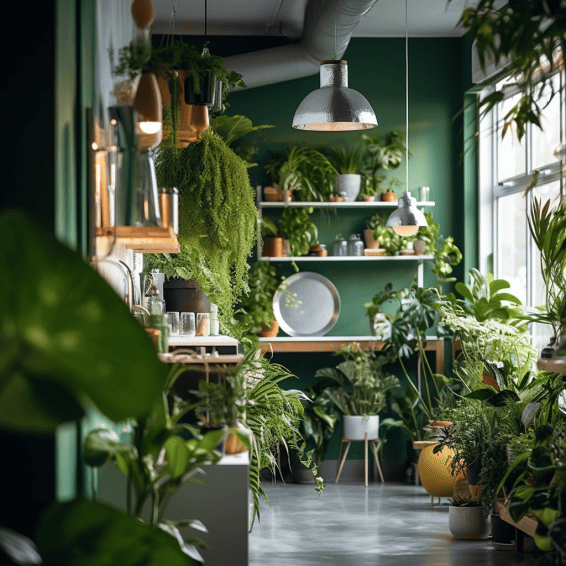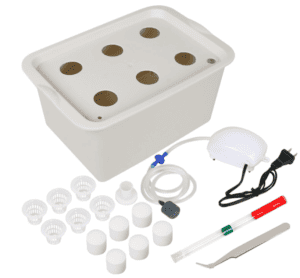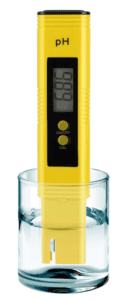“Hydroponics allows plants to grow without soil by delivering nutrients directly…
… to their roots via a water-based solution,” says Dr. Thumb Green, the hydroponics expert…
… who taught me everything I know about soilless gardening.
When I first started, I successfully built my own small-scale hydroponic system…
… using affordable and easily sourced materials.
By mastering techniques like pH monitoring and nutrient dosing, I grew healthy crops.
This guide draws from my experiences as a beginner budgeting creatively to reap bountiful harvests.
Discover insider tips to save money on equipment…
… while supporting vigorous plant growth with robust DIY hydroponic setups.
KEY TAKEAWAY
What to know about hydroponics for beginners?
For beginners diving into hydroponics, understanding the fundamentals of nutrient solutions, plant needs, and system setups is crucial.
Start with a simple system, focus on water quality, and enjoy the rewarding journey of soil-less gardening. (1)
Overview
Source: NT Hydroponics
Hydroponics is a type of gardening where plants grow without soil.
Instead of soil, their roots are supported by an inert growing medium like rockwool or perlite, and the roots are continuously supplied with a nutrient-rich solution.
Cool, huh? The best part is that you can grow fruits, veggies and herbs all year round inside your home without a backyard or garden space.
Why Hydroponics Matters
With hydroponics, you can grow way more food in a smaller space compared to traditional soil gardening.
This is a game changer for folks in cities with small yards or no yard at all.
Starting a hydroponic system is also more beginner-friendly than dealing with soil.
The nutrient solution is already mixed for the plants, so there’s no guesswork about what they need.
And because the roots stay moist, you don’t have to worry as much about watering.
Stress less and get fresh veggies faster with hydroponics!
Getting Started
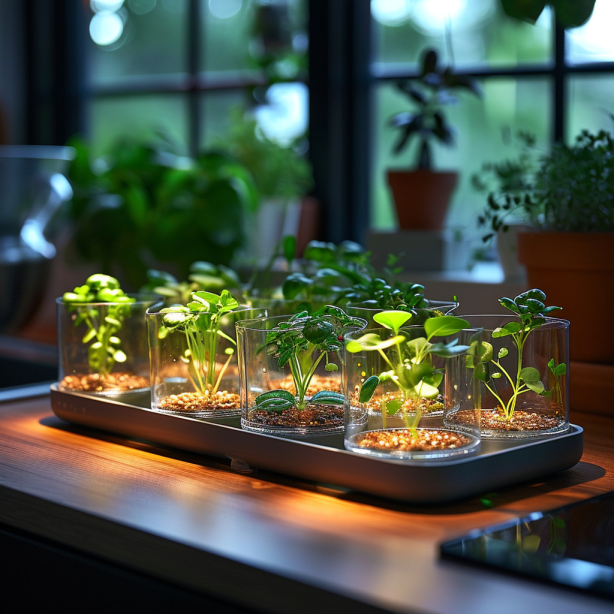
To grow plants hydroponically (2), they need a few key things: light, oxygen, carbon dioxide, water, and nutrients.
Even though there’s no soil, plants still need those building blocks.
Growing mediums like expanded clay or rockwool holds the root structure and wicks moisture.
A powerful grow light provides the full-spectrum plants need to photosynthesize.
An air pump aerates the nutrient solution with oxygen and carbon dioxide.
Modern hydroponic systems circulate the nutrient-rich solution past the roots using different methods.
Some popular at-home hydroponic systems include:
- Nutrient Film Technique (NFT) works by a thin film of water flowing past plants;
- Ebb and flow systems flood the growing tray for set times then drain;
- Wick systems like jars where the wick draws moisture from below;
- Aeroponics which mists the roots directly with nutrient solution.
No matter the setup, starting your own hydroponic garden is easier than you think! Just pick a system like NFT or ebb and flow, assemble your own or buy a starter kit, and you’ll be growing in no time.
Designing Your System
Materials Needed
When designing your DIY hydroponic system, the MOST ESSENTIAL components…
… you will need include a GROW LIGHT, a WATER PUMP, HYDROPONIC NUTRIENTS, and a RESERVOIR.
You will also need planters or containers to hold your plants’ ROOTS.
Popular options include buckets, plastic totes, or ABS pipe fittings.
I prefer buckets myself since they are inexpensive and easy to find.
Whatever you choose, just make sure your containers have drainage holes.
Next, you will need HOLES IN YOUR LIDS or some other way to suspend your planters above your reservoir.
I cut holes in old buckets lids and placed the planters inside.
You can also use styrofoam rafts, net pots, or air/clay pebbles for the plants’ roots to sit in.
And last but not least, airtight connecting tubing is needed to circulate the nutrient solution from your reservoir up to your planters.
I used flexible PVC pipes which have worked like a charm for years! Keep it simple.
With just these FEW BASIC MATERIALS, you’ll have everything you need for a starter hydroponic SYSTEM THAT GROWS.
Expand from there as your skills and garden grows!
Creating a System That Works for You
When designing your hydroponic setup, think about your UNIQUE NEEDS and PREFERENCES.
Do you want to GROW A FEW PLANTS or have a larger operation?
Consider how much TIME AND EFFORT you want to invest in watering, monitoring nutrients, and general maintenance.
A FLOW-THROUGH or EBB AND FLOW SYSTEM works great for beginning gardeners since…
… they require LESS FREQUENT water changes compared to…
… DUTCH BUCKETS or DEEP WATER CULTURE which need daily monitoring.
However, DWC can GROW PLANTS SUPER FAST if you don’t mind the extra effort!
Also think about your GROW SPACE.
A compact setup like aVERTICALTower is perfect for small areas.
I like WINDOW SIGEL systems since they allow me to garden right on my windowsill.
Wherever you decide to locate it, MAKE SURE YOUR SYSTEM GETS PLENTY OF LIGHT.
With some PLANNING, you can create a TAILORED setup to fit your lifestyle.
Remember, KEEP IT SIMPLE at first until you get comfortable with hydroponics.
Then have fun experimenting with new techniques!
DIY or Buy?
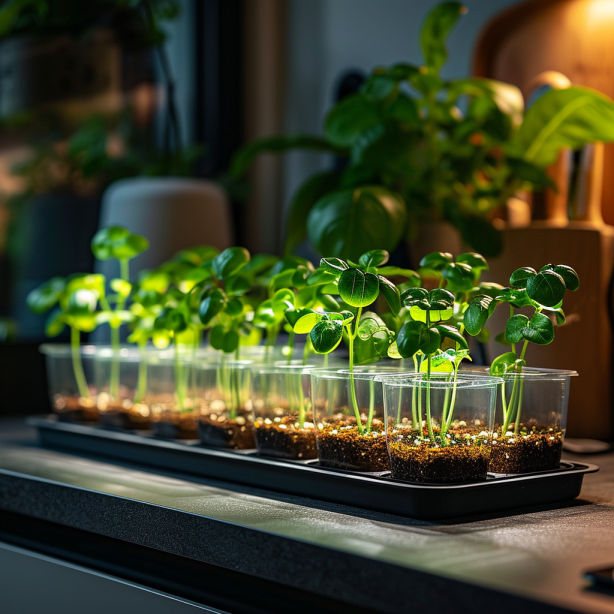
For beginning hydroponic gardeners, the big question is often “should i buy a kit orbuild my own system?”
There are pros and cons to each.
BUYING A KIT is usually quicker and easier since…
… someone else has already done the designing, shopping, and assembly work for you.
Kits also come with detailed instructions so you can get growing faster with less hassle.
However, kits can be more expensive upfront.
BUILDING YOUR OWN SYSTEM allows you to custom design…
… exactly what YOU WANT at a lower total cost by only buying necessary materials.
The satisfaction of building with your own two hands can’t be beat! It also allows you to get familiar with components so future repairs or upgrades are no problem.
My advice? For first-timers, START WITH A SMALL, INEXPENSIVE KIT just to get your feet wet.
Then over time, you can branch out to more advanced homemade systems as your skills improve.
You’ll save money in the long run and have more FUN getting your hands dirty with DIY projects along the way.
Eventually, you’ll be designing systems better than any store-bought kit!
Building Your Hydroponic Garden
Step-by-Step Guide
Building your own hydroponic system is EASY WHEN YOU FOLLOW THESE SIMPLE STEPS!
Whether you go with buckets, PVC pipes or another DIY design, the process is similar.
- First, DRILL HOLES in the bottom of your planters for drainage and air pruning roots.
- Then, add your GROWING MEDIA like expanded clay pellets or coconut coir.
- I find these NATURAL SUBSTRATES help my PLANT ROOTS thrive better than bare plastic.
- Next, ADD YOUR SEEDS OR CLIPPINGS.
- I like to START SEEDS in rockwool cubes before transplanting.
- Make sure to WATER AND FERTILIZE once planted.
- Your seeds will GERMINATE QUICKLY with NUTRIENT RICH WATER.
- Now suspend your planters above the reservoir so the roots dangle in the solution.
- SECURE YOUR GROW LIGHTS about 6-12 inches above the canopy for OPTIMAL PHOTOSYNTHESIS. I use adjustable metal shop lights.
- Top off your reservoir with water and nutrients, following the bottles’ feeding schedule.
- Plug in your air pump to keep the solution OXYGENATED.
And just like that, your GARDEN IS GROWING! Keep following these steps for success.
Aeration and Sterilization
AERATION and STERILIZATION are KEY for a healthy hydroponic system.
Run an air pump at all times to keep the ROOT ZONE oxygenated – MY PLANTS LOVE THE BUBBLES.
I use coarse air stones which last longer.
When refilling the reservoir, be sure to use CHLORINE-FREE TAP WATER.
Chlorine residues can harm delicate roots.
I collect rainwater when available which my veggies appreciate.
Boiling tap water then letting it sit for 24 hours also removes chlorine.
It’s also wise to periodically EMPTY, SCRUB and…
… REFILL your reservoir to PREVENT ALGAL AND BACTERIAL BUILDUP which can CLOG PUMPS OR STUNT GROWTH.
I do a thorough cleaning every 2-3 months with a 10% bleach solution, then triple rinsing.
Keep things shipshape!
Maintenance Tips
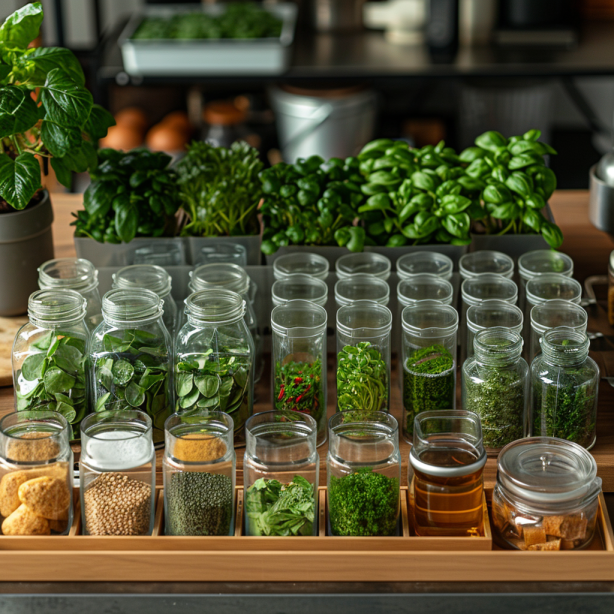
Regular maintenance keeps your hydroponic system running at PEAK PERFORMANCE all season long!
I CHECK PH AND NUTRIENTS WEEKLY, adding just a little more of what my plants need.
PH METERS HELP ensure optimal levels for nutrient uptake.
If algae forms, dilute hydrogen peroxide can zap it fast.
Rotating crops prevents buildup of disease and pests too.
Check your lights, tubing and pump filters occasionally for any BREAKDOWNS.
With some simple LOVE AND CARE, your system will provide an ABUNDANT HARVEST for months to come!
Whenever issues do crop up, don’t stress.
Hydroponics mastery comes with experience.
I’m always learning too! Research online is my troubleshooting best friend.
With POSITIVE ATTITUDES and dedication, your hydroponic home garden dreams will GROW INTO REALITY.
Operating Your Hydroponic System
Planting and Harvesting Schedule
For MOST VEGGIES AND HERBS, I follow a 6-8 WEEK PLANTING SCHEDULE broken into SEASONAL CYCLES.
I start seeds indoors in late winter and transplant outdoors in spring.
Then it’s a STEADY HARVEST through summer before winding down in fall.
With hydroponics, you can squeeze in an extra GENERATION PER YEAR since plants GROW FASTER without competing roots.
I aim to harvest leafy greens like lettuce every 3-4 weeks.
Tomatoes, peppers and herbs take 6-8 weeks before chopping.
Just replant the same day!
Plan your SUCCESSION PLANTING so something is always ready to pick.
LABEL everything so you remember what’s what down the line.
Soon you’ll be enjoying BOUNTIFUL, ORGANIC PRODUCE grown with ease indoors or out.
pH and Nutrients
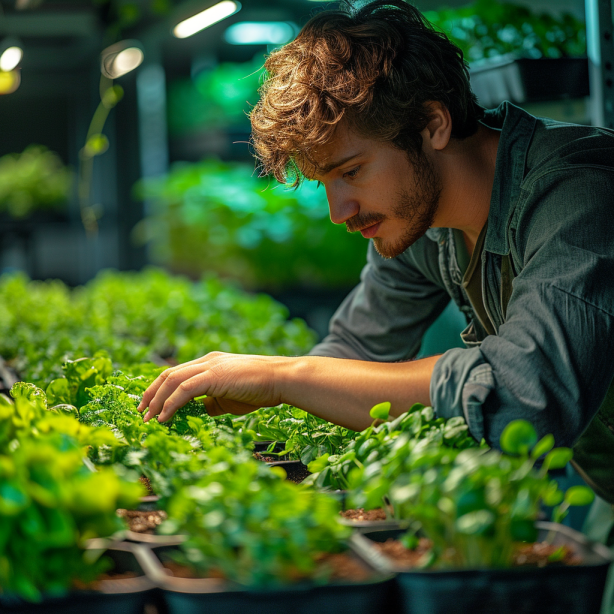
MAINTAINING OPTIMAL pH AND NUTRIENTS IS KEY for hydroponic success.
Most plants thrive when pH is between 5.5-6.5.
I TEST WEEKLY using an inexpensive meter strip.
Hydroponic nutrients provide minerals plants need.
FOLLOW FEED SCHEDULES from brands like General Hydroponics or Maxicrop to avoid deficiencies.
I start seedlings on half-strength to prevent burning delicate roots.
Aeroponic mists my veggies receive the right NUTRIENTS for maximum YIELDS.
Never exceed recommended concentrations which can damage plants.
With a little TLC, your hydrobabies will reward you tenfold!
Cleaning and Harvesting
To KEEP YOUR SYSTEM HEALTHY, CLEAN RESERVOIRS regularly to remove algae, bacteria and debris.
I dump, scrub and refill monthly with gentle soap.
This boosts WATER QUALITY and prevents roots from rotting.
Use sharp scissors or pruners when HARVESTING.
Cut leaves, stems or whole plants 1-2 inches above the growing media.
Be sure to LEAVE ENOUGH FOLIAGE for regrowth too.
And enjoy your fresh, pesticide-free harvest! Sharing extras is a great way to spread hydroponic joy.
Frequently Asked Questions
Can I grow plants without using soil?
Yes, you can grow plants without soil using a method called hydroponics.
In hydroponics, you grow plants in a container with water instead of soil.
The water contains nutrients that the plants will grow from.
What types of hydroponics systems are there for beginners?
There are a few main types of hydroponics systems that are good for beginners.
A wick system has cotton wicks that draw water and nutrients up from a reservoir to the plant roots.
A flood and drain system floods the roots with nutrient solution and then drains it away for the plants to breathe.
A drip system drips nutrient solution directly onto the roots.
How do I start growing with hydroponics as a beginner?
To start growing hydroponically as a beginner, you can build your own simple hydroponics system or buy a pre-made starter kit.
A good first system is a basic flood and drain or drip system.
You’ll also need grow lights if growing indoors.
Research which vegetables and herbs grow best hydroponically to get started.
Keep the water pH levels and nutrients balanced for healthy plant growth.
How do I build a hydroponic system for beginners?
Building a simple hydroponics system is easy and inexpensive for beginners.
You can use plastic storage containers, net pots or cups, an air pump, and tubing.
For a flood and drain system, put your plants in…
… net pots on a tray, flood the tray with nutrient solution, then drain it away so the roots…
… can breathe before the next flood.
An air pump adds oxygen to the water to help the plant roots.
What kinds of plants grow well hydroponically?
Many common vegetables grow very well with hydroponics.
Good herbs to start with include basil, mint and parsley.
Easy vegetables include lettuce, spinach, kale and tomatoes.
Flowers like roses and orchids also grow hydroponically.
Strawberries, cucumbers and peppers can produce high yields hydroponically once you gain experience.
Experiment to find which plants thrive best with your indoor hydroponic method of growing.
How do I maintain the right levels of pH and nutrients?
It is important to regularly test the pH levels and refresh the nutrient solution in your hydroponic system.
Aerate the water with an air pump to keep the roots healthy.
Most hydroponic plants prefer a pH between 5.5 to 6.5 for best nutrient absorption.
Follow the directions on your nutrient bottles and adjust pH up or down as needed with pH up and down solutions.
Replacing one third of the solution weekly helps provide a steady diet for optimum growth.
Conclusion
After reading this guide, you now possess the key knowledge to dive into hydroponic gardening.
You understand what plants need to thrive and have an overview of common hydroponic setups.
Consider starting out small with just a few plants or herb seeds using an affordable system like wick or DWC before scaling up.
Monitor and adjust nutrient solutions carefully.
With some patience through the initial learning curve, first-time hydroponic gardeners…
… can master this innovative soilless technique for growing vibrant, bountiful crops.
Got questions? Leave a comment below. Happy growing!
References
- https://www.thespruce.com/beginners-guide-to-hydroponics-1939215
- https://www.nal.usda.gov/farms-and-agricultural-production-systems/hydroponics#:~:text=Hydroponics%20is%20the%20technique%20of,%2C%20coconut%20coir%2C%20or%20perlite.
Related Articles
- https://tophydroponicgarden.com/diy-hydroponic-kits/
- https://tophydroponicgarden.com/hydroponics-introduction/
- https://tophydroponicgarden.com/best-plants-for-beginners-in-hydroponics/
Was this helpful?

I’m Barrie L., a passionate hydroponic gardening enthusiast dedicated to cultivating thriving, soil-less gardens. With a focus on all things hydroponic, I share my expertise on innovative growing techniques and sustainable practices through my blog, tophydroponicgarden.com. As a seasoned hydroponics specialist, my goal is to inspire and guide fellow gardeners in harnessing the power of water-based cultivation for bountiful and eco-friendly harvests. I’m also an author of the book “Hydroponics For Absolute Beginners: Your Step By Step Guide For How To Create An Hydroponics System At Home Without Soil, For Growing Vegetable, Fruit And Herbs.” which is sold on Amazon. Join me on a journey of redefining the way we cultivate plants, one nutrient-rich solution at a time. Happy growing!

